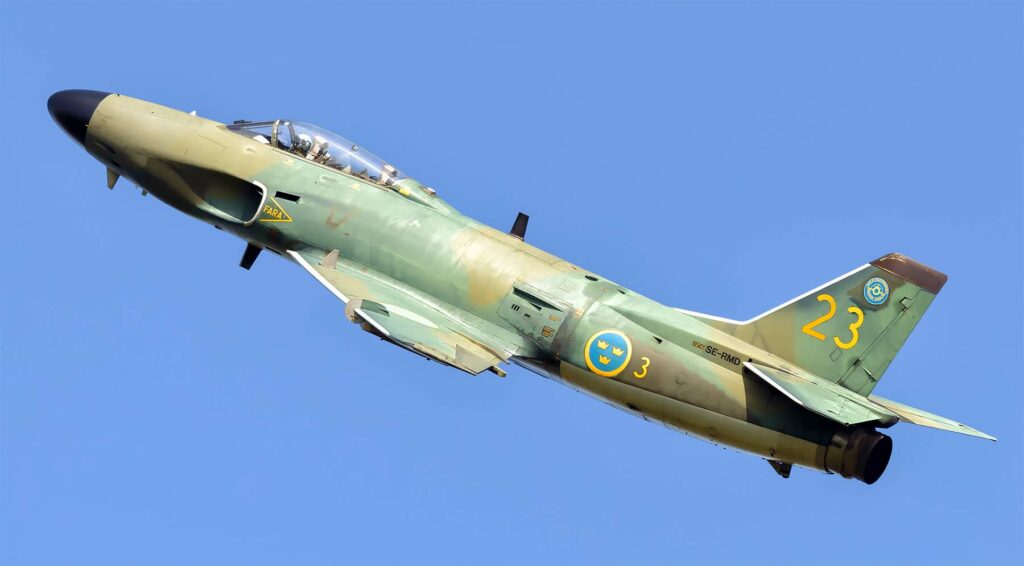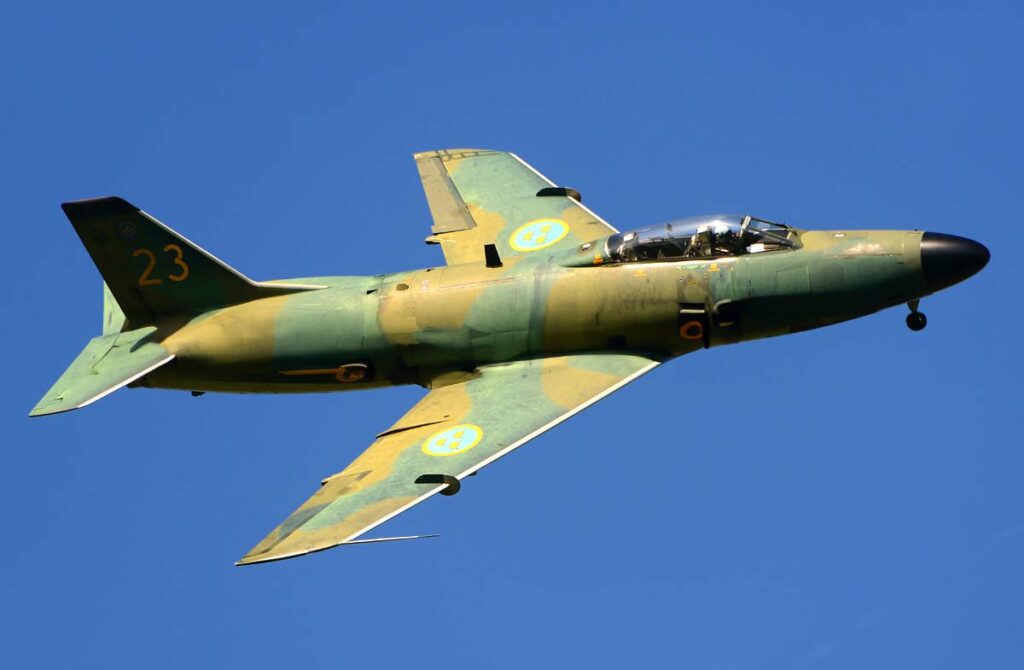The Saab 32 Lansen was a Swedish-built, advanced jet fighter-bomber, renowned for its all-weather capability and versatility in multiple roles.
The Saab 32 Lansen (Lance) was a pivotal aircraft in Sweden’s post-war aviation history, serving as a multi-role fighter-bomber. Introduced in the 1950s, it was designed to meet diverse operational needs, from ground attack to reconnaissance. It was ahead of its time in electronics and weaponry, making it a formidable aircraft in adverse weather conditions. The Lansen significantly advanced Sweden’s domestic aerospace capabilities and became a cornerstone of the Swedish Air Force during the Cold War era.
The Saab 32 Lansen represented a significant leap in technology and capability for the Swedish Air Force in the mid-20th century. It was developed to fulfill a need for a versatile, all-weather, multi-role combat aircraft.

History of the Development of the Saab 32 Lansen
In the early 1950s, Sweden faced a rapidly evolving geopolitical landscape marked by the tensions of the Cold War. The Swedish Air Force needed a modern aircraft capable of operating in diverse roles, including ground attack, reconnaissance, and later, electronic warfare. This need led to the development of the Saab 32 Lansen, a project initiated by Saab and the Swedish government.
The Lansen’s development was a response to the challenges posed by the varied and demanding Swedish environment and the strategic requirements of the era. The program aimed to produce an aircraft that could operate effectively in the harsh Scandinavian climate, particularly in low-visibility and adverse weather conditions.
The Saab 32 Lansen first took to the skies on November 3, 1952, marking a new era in Swedish aviation. It did not receive a NATO nickname, as Sweden was not a member of NATO and the aircraft was specifically designed for the Swedish Air Force.
Design of the Saab 32 Lansen
The Saab 32 Lansen featured a sleek, aerodynamic design, with a swept wing and tail configuration, optimized for high-speed flight. The aircraft was approximately 50 feet (15.24 meters) long, with a wingspan of 33 feet (10.06 meters). The airframe utilized advanced materials and construction techniques of the time, achieving a balance between durability and weight efficiency. This design contributed to the Lansen’s capability to perform a variety of roles effectively, from interception to ground attack, in the challenging climates of Scandinavia.
One of the standout features of the Lansen was its advanced avionics suite, which was highly sophisticated for its time. This included radar and navigation systems that enabled all-weather operational capability, a significant advantage over many of its contemporaries.
However, the design had its limitations. While it excelled in multi-role capabilities, it was not the fastest aircraft in its class, and its adaptability came at the cost of specialization in any single role.
Performance of the Saab 32 Lansen
The Saab 32 Lansen was powered by a Svenska Flygmotor RM6B/C turbojet engine, a licensed-built version of the Rolls-Royce Avon. This engine delivered a thrust of approximately 10,000 pounds-force (44.48 kN). The power generated by this engine enabled the Lansen to achieve a top speed of approximately 690 mph (1,110 km/h), with an operational ceiling of 50,000 feet (15,240 meters). The range of the Lansen was about 2,000 miles (3,220 kilometers), which was well-suited for the diverse range of missions envisioned within Sweden’s defense strategy, from domestic air defense to reconnaissance and attack missions.
In comparison to other aircraft of the era, the Lansen was a competent performer, particularly in its all-weather capabilities. While not the fastest, its advanced avionics and versatility allowed it to hold its own against contemporaries like the British Hawker Hunter and the American F-86 Sabre in certain aspects.

Military Use and Combat of the Saab 32 Lansen
The Saab 32 Lansen was armed with a versatile array of weaponry, tailored to its multi-role capabilities. This included four 20 mm Bofors cannons mounted in the nose for air-to-air and air-to-ground combat. For ground attack missions, it could be equipped with a combination of bombs and rockets, including 75 mm air-to-ground rockets and various types of conventional bombs. In its maritime strike role, the Lansen could carry anti-ship missiles, notably the RB04, one of the world’s first sea-skimming anti-ship missiles. Additionally, it was capable of deploying air-to-air missiles for self-defense in its later service years.
The Lansen’s diverse armament made it a formidable platform for a range of missions, from ground attack to maritime strike and reconnaissance. Its service in the Swedish Air Force was extensive, with a focus on national defense roles in line with Sweden’s non-aligned status during the Cold War. The aircraft’s adaptability and robust armament allowed it to effectively patrol and defend Swedish airspace and territorial waters without involvement in international conflicts.
The Lansen played a critical role in maintaining Sweden’s air defense and sovereignty during this period. Its operational flexibility and reliability were key factors in its prolonged service life.
The Saab 32 Lansen, being a specialized aircraft tailored to the unique requirements of Sweden’s defense strategy, was not exported to other countries. It remained an exclusive element of the Swedish defense apparatus throughout its service life. The Lansen remained in active service until 1978, after which it was gradually phased out and replaced by more modern aircraft, including the Saab 37 Viggen. The Viggen offered advanced capabilities and technologies that better suited the evolving needs of the Swedish Air Force in the latter part of the 20th century.
The Saab 32 Lansen stands as a symbol of Swedish innovation and self-reliance in military aviation. Its development and successful deployment demonstrated Sweden’s ability to produce an aircraft that met specific national requirements, balancing performance, versatility, and technological advancement. The Lansen’s legacy is reflected in its significant contribution to the Swedish Air Force and its influence on subsequent Swedish aircraft designs.
Back to the Fighter Jet section.